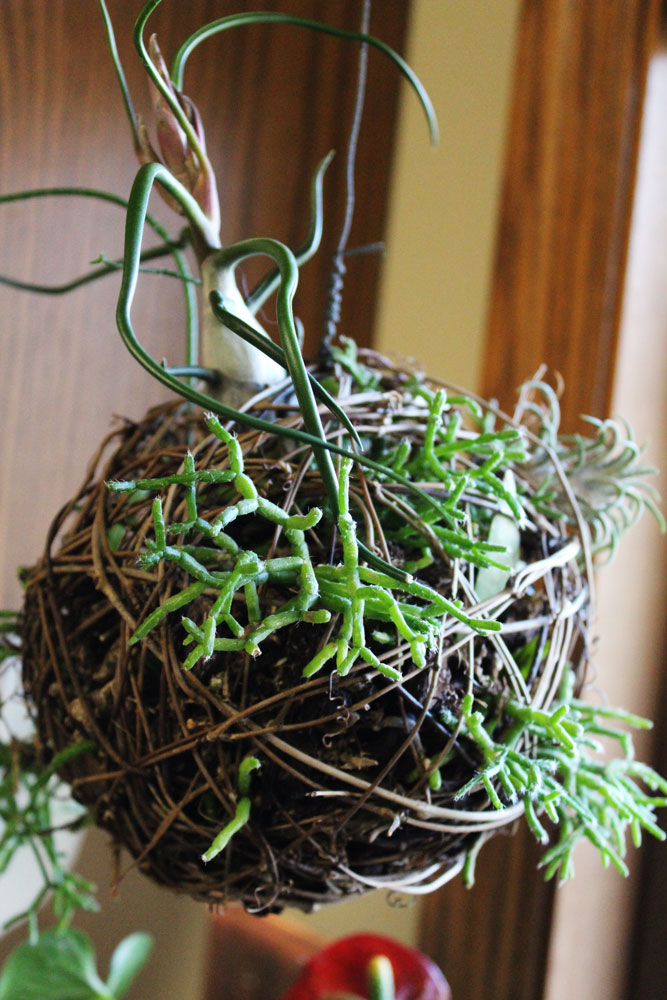
Best Plants for Miniature Gardens
The Almanac Garden Planner - Use It Free for 7 Days!
Plan your 2025 garden with our award-winning Garden Planner.
ADVERTISEMENT
In the article Gardening in Miniature,
Best Plants for Miniature Gardens and Fairy Gardnes
By Doreen G. Howard
You show a Grapevine ball with a delicate tiny succulent growing on it - it is not a tillandsia at least not from what I can find - We have one at home and no-one knows what it is but it very delicate. Can you help me know what it's name is esp if it has a simple name.
Thank you
Eric
February 4, 2020
Hello Eric,
The plant pictured in the first image of this article is a succulent of the genus Rhipsalis. They are commonly called “mistletoe cactus” and are epiphytic, meaning they tend to grow on tree branches rather than in the soil (like air plants). A very unique and interesting plant—enjoy yours!
Thank you. What lovely ideas. I have a Delft KLM house from decades ago, on my stove ever since but I'm now thinking would make the perfect focal point for a miniature kitchen garden, maybe with moss, as flying over Holland I remember those vast fields of GREEN! Not to change the subject, but I read the comment by Etta, below. I came across that author's presentation on Restoration Agriculture half a dozen years ago (on line), 2-1/2 hrs I sat rapt, I so related to everything he said. Nothing has made me more optimistic about the future than that introduction to permaculture and farming in line with nature, the perfect antidote to the food-shortage fearmongering! :D
Fairy gardens are MUCH MORE than miniature plants and trinkets and baubles. They are the home of a fairy. The plants and accessories should be those that are useful to the fairy or have a special meaning to him/her. One must know about fairies and do some homework to plant a proper fairy garden. Come visit my facebook page Fairy Garden Queen (community) to learn more!
I'm reading a fantastic book, "Restoration Agriculture" by Mark Shepard. He talks about moving our planting consciousness from "annuals" to "perennials"! I've always had a perennial flower garden but Shepard has helped (and horrified) me into realizing that the greatest civilizations have been brought low by monocrops (annuals like corn,soy,wheat) which also are VERY low in nutritional value compared to perennials (walnut/chestnut/hazelnut, peach/pear/plum, apple, berry, fungi/mushroom). I planted a peach tree 2 years ago and had a bumper crop last summer. It's healthy and ready to blossom now~so excited! * p.s. to Marybeth K. living with only a woodburning stove: have you heard about "Air Plants"? Supposedly, you don't need a green thumb.
Sounds like a fascinating book. The author's supposition makes sense. Mono-culture of annual foods has lead to famine and destruction of many societies.
Thanks for the link! Miniature gardens are super easy, and I think it woud be a great way to get kids interested in garden.
i have always enjoyed gardening but have recently moved and don't have a outside yard available. i really like your photos and ideas espeicially the fairy gardens and the air ball...i'm got incentive now. thxs
Hello! I always had a fairy garden outside in the back yard! this year I will create one out of an old wheel barrel. My question is ; I only have a wood burning stove in my house for the winter months. most all of my house plant die because of the cold! Do you have any suggestions for me? thank you Marybeth
Pot-quilts around your planters can help keep roots warm. You might also 'blanket' the top of the soil with leaf or grass mulch. Don't forget to keep water always simmering on the woodstove so neither you nor your plants dry out. :)













